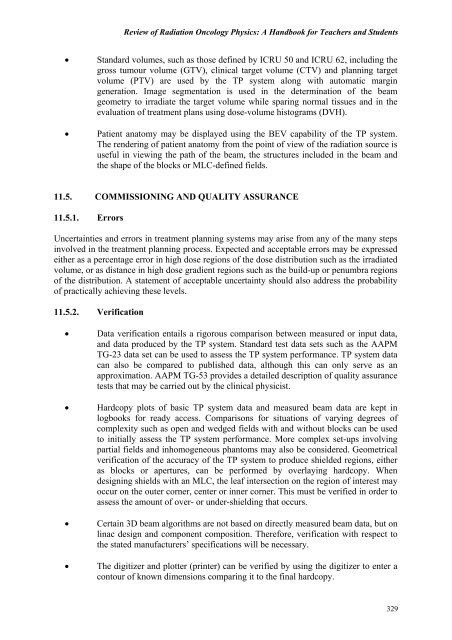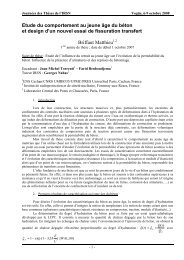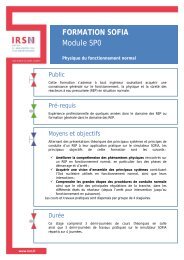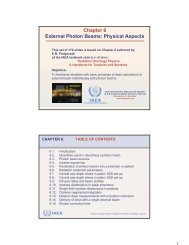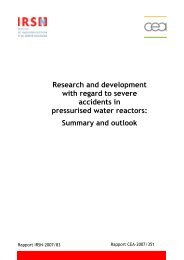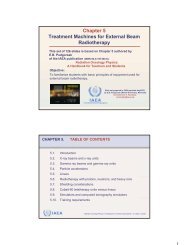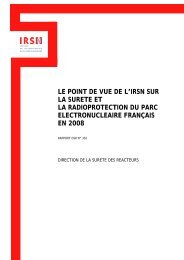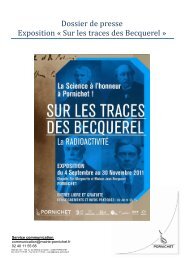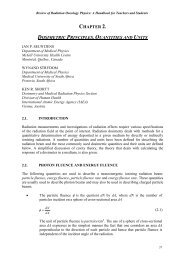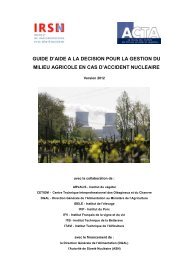Review of Radiation Therapy Physics: A syllabus for teachers ... - IRSN
Review of Radiation Therapy Physics: A syllabus for teachers ... - IRSN
Review of Radiation Therapy Physics: A syllabus for teachers ... - IRSN
Create successful ePaper yourself
Turn your PDF publications into a flip-book with our unique Google optimized e-Paper software.
<strong>Review</strong> <strong>of</strong> <strong>Radiation</strong> Oncology <strong>Physics</strong>: A Handbook <strong>for</strong> Teachers and Students• Standard volumes, such as those defined by ICRU 50 and ICRU 62, including thegross tumour volume (GTV), clinical target volume (CTV) and planning targetvolume (PTV) are used by the TP system along with automatic margingeneration. Image segmentation is used in the determination <strong>of</strong> the beamgeometry to irradiate the target volume while sparing normal tissues and in theevaluation <strong>of</strong> treatment plans using dose-volume histograms (DVH).• Patient anatomy may be displayed using the BEV capability <strong>of</strong> the TP system.The rendering <strong>of</strong> patient anatomy from the point <strong>of</strong> view <strong>of</strong> the radiation source isuseful in viewing the path <strong>of</strong> the beam, the structures included in the beam andthe shape <strong>of</strong> the blocks or MLC-defined fields.11.5. COMMISSIONING AND QUALITY ASSURANCE11.5.1. ErrorsUncertainties and errors in treatment planning systems may arise from any <strong>of</strong> the many stepsinvolved in the treatment planning process. Expected and acceptable errors may be expressedeither as a percentage error in high dose regions <strong>of</strong> the dose distribution such as the irradiatedvolume, or as distance in high dose gradient regions such as the build-up or penumbra regions<strong>of</strong> the distribution. A statement <strong>of</strong> acceptable uncertainty should also address the probability<strong>of</strong> practically achieving these levels.11.5.2. Verification• Data verification entails a rigorous comparison between measured or input data,and data produced by the TP system. Standard test data sets such as the AAPMTG-23 data set can be used to assess the TP system per<strong>for</strong>mance. TP system datacan also be compared to published data, although this can only serve as anapproximation. AAPM TG-53 provides a detailed description <strong>of</strong> quality assurancetests that may be carried out by the clinical physicist.• Hardcopy plots <strong>of</strong> basic TP system data and measured beam data are kept inlogbooks <strong>for</strong> ready access. Comparisons <strong>for</strong> situations <strong>of</strong> varying degrees <strong>of</strong>complexity such as open and wedged fields with and without blocks can be usedto initially assess the TP system per<strong>for</strong>mance. More complex set-ups involvingpartial fields and inhomogeneous phantoms may also be considered. Geometricalverification <strong>of</strong> the accuracy <strong>of</strong> the TP system to produce shielded regions, eitheras blocks or apertures, can be per<strong>for</strong>med by overlaying hardcopy. Whendesigning shields with an MLC, the leaf intersection on the region <strong>of</strong> interest mayoccur on the outer corner, center or inner corner. This must be verified in order toassess the amount <strong>of</strong> over- or under-shielding that occurs.• Certain 3D beam algorithms are not based on directly measured beam data, but onlinac design and component composition. There<strong>for</strong>e, verification with respect tothe stated manufacturers’ specifications will be necessary.• The digitizer and plotter (printer) can be verified by using the digitizer to enter acontour <strong>of</strong> known dimensions comparing it to the final hardcopy.329


